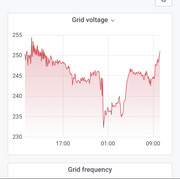I don't know anything about hoymiles, so I don't know if you have access to its settings. If you can set it to a UK spec it ought to keep working up to 264v ish. That would be the optimum solution.
You can get voltage optimisers that reduce the supply voltage to your house, though I'm not convinced they would save you any money as they claim. This one seems to be an autotransformer that reduces the voltage by 7.5% (~18v):-
https://www.cef.co.uk/catalogue/product ... ation-unit
If I were considering this solution myself I'd probably cobble up something similar, but just for the hoymiles, not the whole house, which would be much cheaper:
E.g. if you were just going slightly over 253v with an inverter that could output up to 15A a.c., then knocking off 10v would suffice, so I would look for something like a 150va 10v: 230v, (I.e. 15A at 10v output) transformer. Connect the 10v winding in series with the 230v winding to make a 230/240v autotransformer. Check you've got the polarity right by connecting 230v to the 230v 'tapping', and the output from the ends should be 10v more, not 10v less. Connect the '240v' to the grid side and the hoymiles to the 230v tapping, and the hoymiles should see grid -10v, approximately.
If the output of the hoymiles is approaching 253v the output from the autotransformer will be near 264v though, which is still OK, but it is the reason I suggest a 10v transformer: a 20v transformer would get the apparent voltage at the hoymiles nearer to 230v at grid=250v, but then the hoymiles wouldn't cut out until the grid reached 253+20v, which would be inadvisable.




